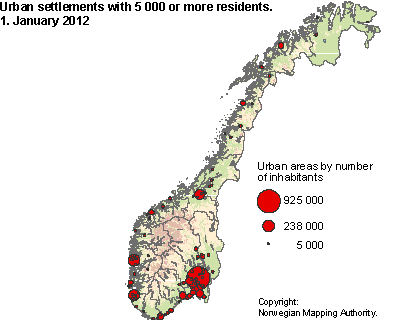Content
Published:
This is an archived release.
4 million inhabitants in urban settlements
Almost four million of the total population of 5 million inhabitants in Norway lived in urban settlements as of 1 January 2012. Ninety per cent of the growth in the population of Norway took place in the urban settlements.
The number of inhabitants in urban settlements increased by 60 000, or 1.5 per cent in 2011. The area covered by urban settlements increased by 20 square kilometres, or 1 per cent.
The highest growth in the urban population occurred in the central part of eastern Norway (counties of Oslo and Akershus). The lowest rate of increase in the population in urban settlements in 2011 was recorded in North Norway.
Continued high growth in the largest cities
The population of Oslo increased by 18 500 in 2011, or 32 per cent of the total increase in the urban settlements of Norway. A total of 925 000 inhabitants lived in the urban settlement of Oslo, which constitutes 23 per cent of the total population in urban settlements in Norway as of 1 January 2012.
In addition to Oslo, the urban settlements Bergen, Stavanger/Sandnes, Trondheim, Fredrikstad/Sarpsborg and Drammen all have more than 100 000 inhabitants. The population of these five urban settlements increased by 12 000, or 20 per cent of the total increase in urban settlements. In total, 815 000 inhabitants lived in these five urban settlements as of 1 January 2012.
| 2012 | Change from 2011 to 2012 | ||||||||||||||||||||||||||||||||||||||||||||||||||||||||||||||||||||||||||||||
|---|---|---|---|---|---|---|---|---|---|---|---|---|---|---|---|---|---|---|---|---|---|---|---|---|---|---|---|---|---|---|---|---|---|---|---|---|---|---|---|---|---|---|---|---|---|---|---|---|---|---|---|---|---|---|---|---|---|---|---|---|---|---|---|---|---|---|---|---|---|---|---|---|---|---|---|---|---|---|---|
| Residents | Area. km 2 | Residents per km 2 | Number of urban settlements | Residents | Area. km 2 | Residents per km 2 | Number of urban settlements | ||||||||||||||||||||||||||||||||||||||||||||||||||||||||||||||||||||||||
| Total | 3 958 038 | 2 422.87 | 1 634 | 942 | 58 923 | 19.63 | 12 | 6 | |||||||||||||||||||||||||||||||||||||||||||||||||||||||||||||||||||||||
| 200-499 residents | 114 419 | 167.12 | 685 | 337 | 1 728 | 1.63 | 3 | 4 | |||||||||||||||||||||||||||||||||||||||||||||||||||||||||||||||||||||||
| 500-999 residents | 163 058 | 201.59 | 809 | 234 | -1 165 | -1.07 | -1 | -2 | |||||||||||||||||||||||||||||||||||||||||||||||||||||||||||||||||||||||
| 1 000-1 999 residents | 202 890 | 207.74 | 977 | 144 | -1 331 | 0.26 | -8 | 0 | |||||||||||||||||||||||||||||||||||||||||||||||||||||||||||||||||||||||
| 2 000-19 999 residents | 1 101 586 | 827.81 | 1 331 | 206 | 1 969 | 2.35 | -1 | 3 | |||||||||||||||||||||||||||||||||||||||||||||||||||||||||||||||||||||||
| 20 000-99 999 residents 1 | 636 254 | 368.63 | 1 726 | 15 | 27 108 | 13.63 | 10 | 1 | |||||||||||||||||||||||||||||||||||||||||||||||||||||||||||||||||||||||
| 100 000 or more residents | 1 739 831 | 649.98 | 2 677 | 6 | 30 614 | 2.73 | 36 | 0 | |||||||||||||||||||||||||||||||||||||||||||||||||||||||||||||||||||||||
| 1 | Molde is now included in the sizegroup 20 000-99 999 residents. |
The largest urban settlements in minority
As few as 21of the 942 urban settlements in Norway had 20 000 or more residents as of 1 January 2012. These constitute as much as 60 per cent of the total population in urban settlements, but only 42 per cent of the total area covered by urban settlements.
Continued growth in population density
In total, 2 423 square kilometres of the total area of Norway were urban settlements as of 1 January 2012.
In recent years, the increase in the number of residents in urban settlements has been slightly stronger than the increase of the total area in urban settlements.
The average population density for urban settlements in Norway was 1 634 on 1 January 2012, compared to 1 593 on 1 January 2007.
Urban settlementA hub of buildings is registered as an urban settlement if it is inhabited by at least 200 persons. The distance between the buildings must not exceed 50 metres. Exceptions are allowed for areas that cannot/are not to be occupied, for example parks, sport facilities, industrial areas or natural barriers such as rivers or arable land. Agglomerations that naturally belong to the urban settlement with up to a distance of 400 metres from the centre of the urban settlement are also included. |
Tables:
Contact
-
Even Høydahl
E-mail: even.hoydahl@ssb.no
tel.: (+47) 95 77 79 06
-
Dana Moe
E-mail: dana.moe@ssb.no
tel.: (+47) 99 85 23 42
-
Vilni Verner Holst Bloch
E-mail: vilni.verner.holst.bloch@ssb.no
tel.: (+47) 94 82 25 32
-
Statistics Norway's Information Centre
E-mail: informasjon@ssb.no
tel.: (+47) 21 09 46 42

